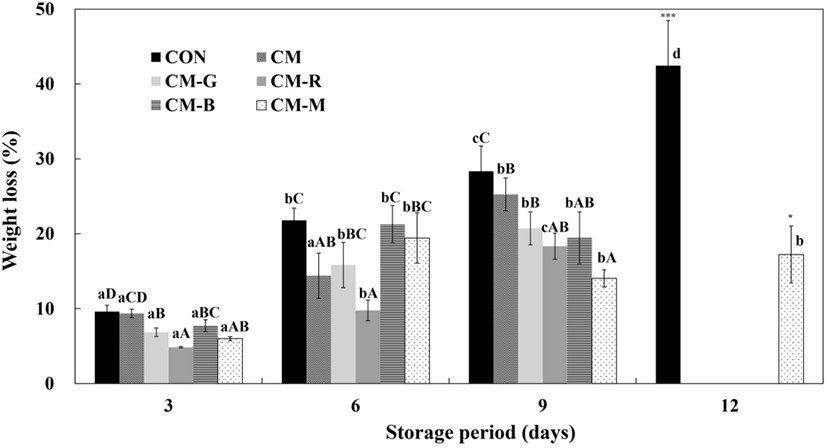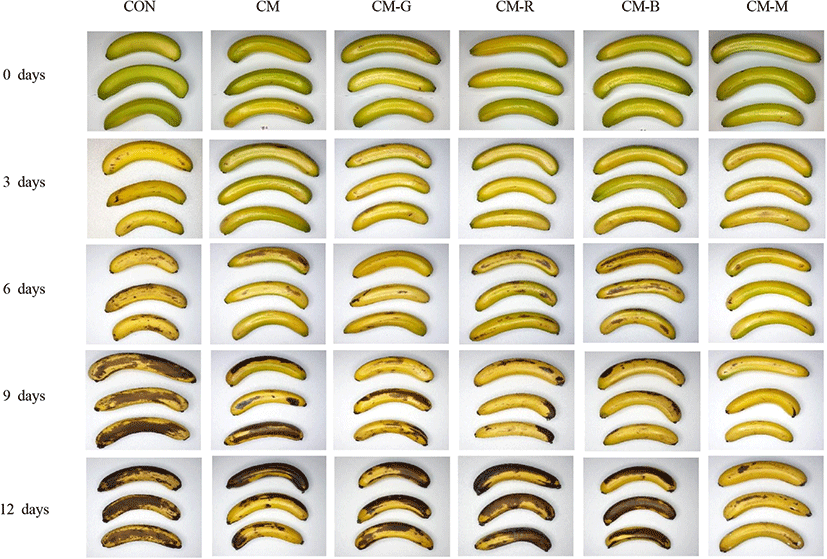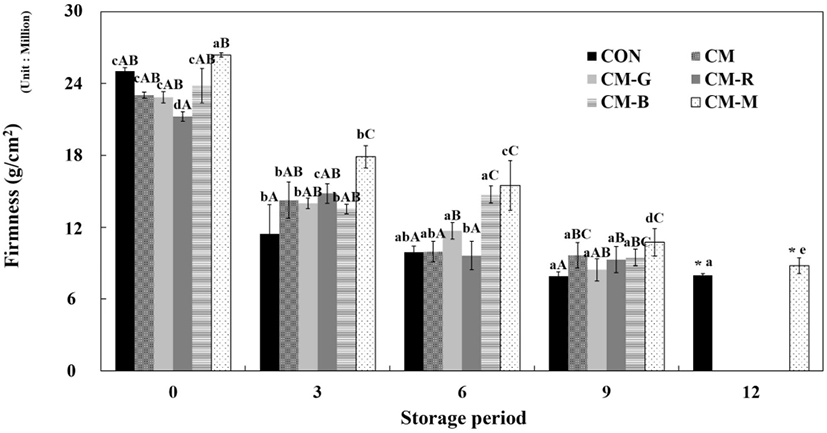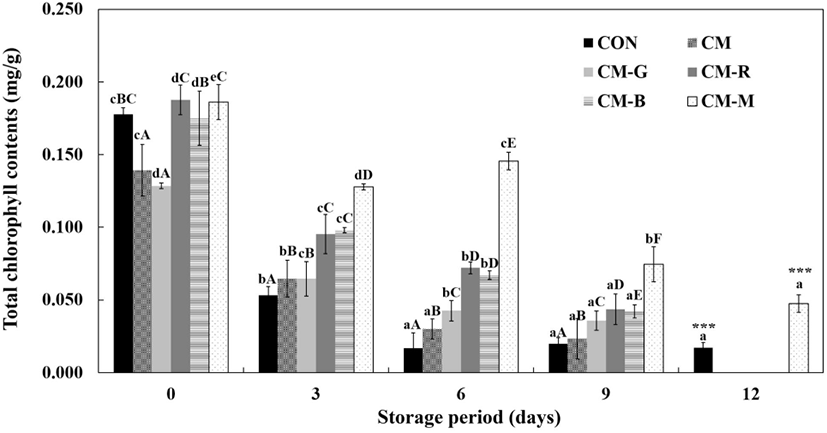서 론
바나나(Musa acuminata Cavendish Subgroup)는 파초과에 속하는 식물로 인도, 중국, 필리핀 등에서 주로 생산되고 있으며 칼륨, 비타민 C 및 B6, 섬유질, 트립토판 등의 아미노산이 풍부하다(Sheehy과 Sharma, 2011). 바나나는 녹색 단계에서 수확되며 숙성 중 엽록소의 파괴로 인해 과피가 황색으로 변화한다(Dadzie와 Orchard, 1997). 바나나의 숙성이 진행될수록 황색 바탕에 불균일한 갈색 반점이 나타나게 되고, 반점이 많아지면 결국 갈색으로 보이게 되는 특성을 가지고 있다(Choehom 등, 2004). 이러한 바나나의 갈변은 유통 과정에서 매우 빠르게 진행되기 때문에 치명적인 품질 저하로 이어지며, 수확 후 충격 및 압박을 받을 경우 표피 갈변과 과육의 연화로 인해 상품가치가 현저하게 떨어지는 문제는 바나나 산업에 있어서 많은 문제가 되고 있다(Huang 등, 2013; Kim과 Youn, 2013). 따라서 바나나 껍질 색상은 품질을 결정하는데 있어 가장 중요한 요소로 판단될 수 있으며, 이를 조절할 수 있는 기술의 개발이 필요하다(Mendoza와 Aguilera, 2004). 과일의 품질 유지나 갈변 방지를 위해 환원제 및 킬레이트제 등의 화학 물질을 직접 처리하거나(Son 등, 2016), 효소 활성 조절을 이용하는 열처리(Sim 등, 2016), 물질의 투과성을 제어하는 가식성 코팅처리(Hur, 2015) 및 저장 환경 기체 조성을 변경하는 포장처리(Kim 등, 2017) 등의 방법이 다양하게 이용되고 있다.
가식성 코팅은 ‘가스, 수증기 및 용재의 투과를 선택적으로 차단하는 동시에 물리적 보호 효과를 부여하기 위해 포장, 담금, 도포, 분무 등의 방법으로 가식성 물질을 식품 표면에 얇은 층막으로 입힌 것’으로 정의된다(Baldwin 등, 1995). 가식성 코팅은 활성 포장의 한 가지 형태로 포장 내, 외부 환경과 능동적인 상호 작용을 통하여 식품 포장 성능을 향상시키는데 도움을 준다. 또한 수분과 기체 교환에 대한 부분적인 barrier로 작용될 수 있고, 식품첨가물(갈변억제제, 항균제)들을 함께 적용할 수 있는 장점이 있다(Debeaufort 등, 1998). 가식성 코팅제로 이용되는 소재는 다당류, 단백질, 지방 등이 있으며, 이중 carboxymethyl cellulose(CMC)는 다당류 기반의 소재로서 가용성이며 긴 사슬 구조의 분자 구조를 가지고 있고, 수용성 및 음 이온성이라는 특징이 있다(Chiumarelli 와 Hubinger, 2012; Fernandez-Pan 등, 2014; Hassan 등, 2018). 또한 CMC를 가식성 코팅으로 적용할 때 반투과성 장벽으로서의 작용을 하여 수분 및 용질 가스 교환을 억제함으로써 유통기한을 연장할 수 있다(Saba와 Sogvar, 2016). 화학 물질 대용으로 과일의 갈변 억제에 유효한 것으로 알려진 녹차(Camellia sinensis), 붉나무(Rhus chinensis), 쌀겨(Oryza sativa Bran), 뽕나무의 뿌리껍질인 상백피(Morus alba)와 같은 천연물 유래 추출물은 높은 항산화력으로 인해 과일의 산화를 방지하고 갈변을 지연시킬 수 있다는 연구 결과를 확인할 수 있다(Chang 등, 2012; Jee 2009; Noh 등, 2017; Park 등, 2014). 그러나 가식성 코팅에 다양한 천연 갈변 저해제를 첨가하여 코팅제별 갈변 저해 효과를 비교한 연구는 거의 찾아볼 수 없다.
따라서 본 연구에서는 바나나의 갈변을 저해할 수 있는 기술을 개발하기 위한 기초 자료를 얻기 위해 범용되고 있는 다양한 갈변 저해제를 달리하여 제조한 가식성 코팅을 적용하였다. 그 후 저장기간 동안 바나나의 중량감소율, 경도, polyphenol oxidase(PPO) 활성, browning index(BI), 총엽록소 함량, 색차 및 색도에 미치는 영향을 조사하여 품질 특성 유지에 가장 적합한 가식성 코팅의 갈변저해 효과를 확인하였다.
재료 및 방법
바나나(Musa acuminata Cavendish Subgroup)는 필리핀 부키드논 주에서 재배되었으며, 2020년도 1월 대구광역시 농산물 시장에서 구입하였다. 육안으로 판별 시 외관 색택이 균일하고 상처가 없는 120.0±20.0 g의 바나나를 선별한 후 200 ppm 농도의 NaClO 용액에 1분간 침지한 후 증류수로 세척하고, 겉에 묻은 물기를 제거하여 실험을 진행하였다. 천연 갈변 저해제는 녹차, 붉나무, 쌀겨, 상백피 분말 각 100 g에 10배의 증류수를 첨가하여 40°C에서 12시간 진탕 추출한 뒤 고형분 함량이 0.5 °Brix가 되도록 증류수로 희석한 추출물을 ㈜다인솝(Cheongju, Korea)으로부터 제공 받아 사용하였다. 열수 추출한 천연 갈변저해제들을 가식성 코팅제의 제조에 이용하였다.
코팅제는 증류수에 carboxyl methyl cellulose sodium salt(CMC)(Tokyo Chemicals Industry Co., Ltd., Tokyo, Japan) 1.5%(w/v), Tween 80(Daejung Chemicals & Metals Co., Ltd., Siheung, Korea) 2.0%(w/v)와 다양한 천연 갈변 저해제(녹차, 붉나무, 쌀겨, 상백피)를 1.5%(w/v) 첨가하여 40(±5)°C에서 12시간 동안 120 rpm의 속도로 혼합하여 제조하였다. 실험에 사용된 샘플은 무처리구(CON)와 코팅제는 갈변 저해제를 첨가하지 않은 코팅제(1.5% CMC와 2.0% Tween80)(CM), CM과 1.5% 갈변저해제를 첨가한 녹차 추출물 코팅제(CM-G), 붉나무 추출물 코팅제(CM-R), 쌀겨 추출물 코팅제(CM-B), 상백피 추출물 코팅제(CM-M)를 제조하여 바나나에 처리한 후 품질특성 및 성분함량을 측정하였다.
가식성 코팅제의 처리는 hand brushing 방법을 이용하여 진행하였다. 넓은 평붓으로 가로로 눕힌 바나나의 단면에 코팅제를 1회 도포하고 dryer(BL950903, Gumbok Stoke Co., Ltd., Seoul, Korea)를 이용해 20°C에서 15분간 건조하는 방식으로 한 면에 2회, 한 개체당 총 4번의 코팅을 진행하였다. 시료의 저장은 13°C 항온기(JSBI-300C, JS Research Inc., Gongju, Korea)에서 12일간 보관하며 3일 간격으로 분석하였으며, 저장 0일차의 경우 코팅제의 처리 후 완전히 건조하여 부착했다고 판단되는 2시간 후 분석을 진행하였다(Eum 등, 2009). 그리고 CM-M을 제외한 다른 코팅 처리구에서 저장 12일차 이후부터 시료의 외관 갈변이 무처리구(CON)와 유사하게 진행되었기 때문에 실험에 사용하기 부적합하다고 판단되어 실험에서 제외하였다.
바나나의 중량 감소율은 저장기간 동안 바나나의 전체 질량의 감소 정도를 백분율로 나타낸 값이며, 6회 반복 측정 후 다음 식에 의해 산출하였다.
w0: 코팅처리 직후 중량
w1: 회차별 측정 중량
바나나의 경도 측정은 껍질을 제거하지 않은 바나나 표면의 가운데와 양쪽 1/3 지점의 경도(firmness)를 측정하였다. 경도 측정은 rheometer(Compac-100Ⅱ, Sunscientific Co., Tokyo, Japan)를 이용하였으며, 각 바나나별로 3회, 총 18회 측정 후 평균값으로 나타내었다. 물성 측정 시 측정조건은 sample type: cylinder, Table speed: 180 mm/min, distance: 6.80 nm(20%) 조건에서 3 mm circle type adaptor를 사용하여 측정하였다.
PPO 활성은 Yang(2009)의 방법을 변형하여 측정하였다. 바나나 껍질 5 g에 polyvinylpolypyrrolidone(PVPP, Sigma Chemical Co., St. Louis, MO, USA) 2.5 g과 0.2 M sodium phosphate buffer(pH 7.0) 45 mL를 가하여 30초간 균질화했다. 균질액을 원심분리기(1580MGR, Gyrozen, Deajeon, Korea)로 10,000 ×g, 4°C에서 5분간 원심분리한 후 얻은 상등액을 조효소액으로 사용하였다. 조효소액 0.6 mL와 20 mM catechol (1,2-dihydroxybenzene, Sigma Chemical Co.)을 포함한 0.05 M sodium phosphate buffer(pH 7.0) 2.4 mL를 반응시킨 후 UV-visible spectrophotometer(Evolution 201, ThermoFisher Scicentific, Waltham, MA, USA)를 이용하여 420 nm에서 흡광도를 측정하였다. PPO 활성은 1분당 0.001의 흡광도 변화량을 1 unit로 하여 unit/g/min으로 나타내었다.
BI는 Supapvanich 등(2011)의 방법을 변형하여 분석하였다. 바나나 껍질 2 g에 65% ethanol 용액(Duksan Pure Chemicals Co., Ltd., Ansan, Korea) 40 mL를 넣고 35°C에서 40 kHz의 초음파를 가하여 1시간 동안 추출 후 여과(Whatman No.2 filter paper)하였다. 여과액은 UV-visible spectrophotometer(Evolution 201, ThermoFisher Scicentific)를 이용하여 420 nm에서 흡광도를 측정하여 갈변 지수는 ABS(420 nm)값으로 나타내었다.
총엽록소 함량 측정은 Jatoi 등(2017)의 방법을 변형하여 측정하였다. 바나나 껍질 3 g에 90% acetone(Duksan Pure Chemicals Co., Ltd.)용액 27 mL를 가한 뒤 Shaking incubator (JSSI-300C, JS Research Inc.)를 이용하여 20°C에서 180 rpm의 속도로 30분 동안 추출한 후 암실에 24시간 방치하였다. 추출물을 여과(Whatman No.4 filter paper)하여 여과액을 0.20 μm membrane filter로 한 번 더 여과한 후 663 nm 및 645 nm에서 UV-visible spectrophotometer(Evolution 201, ThermoFisher Scicentific)를 이용하여 흡광도를 측정하였다. 총 엽록소 함량은 3회 반복 측정 후 다음 식에 의해 산출하였다.
바나나의 색도 측정은 껍질을 제거하지 않은 바나나 표면의 가운데와 양쪽 1/3 지점을 측정하였다. 백색판(L*=97.79, a*=-0.38, b*=2.05)으로 보정된 colorimeter(CR-400, Konica Minolta Co., Osaka, Japan)를 이용해 CIELAB 값을 측정하였으며, 명도(L*=lightness), 적색도(a*=redness), 황색도(b*= yellowness)로 나타냈다. Total color different(ΔE)는 다음 식에 의해 산출하였다.
L0*: Initial lightness value of the source
a0*: Initial redness value of the source
b0*: Initial yellowness value of the source
결과 및 고찰
코팅 처리한 바나나의 저장 중 중량감소율의 변화는 Fig. 1과 같다. 중량감소율은 저장 기간이 증가함에 따라 전반적으로 증가하는 경향을 보였다. 특히 CON의 경우, 저장 6일차부터 급격하게 증가하여 저장 12일 후에는 42.45±2.45%로 가장 큰 증가율을 보였으며, CM-M의 경우 5.98±0.79-17.22±3.80%로 꾸준하게 낮은 결과를 유지했다. Adeyemi와 Oladiji(2009)에 따르면 바나나의 수분 함량은 약 70-80%로 구성되어 있으며, 과일의 중량 감소는 과일 조직 내부의 수분이 외부로 빠져나가는 증산현상 또는 호흡 과정에서 발생하게 된다(Cha 등, 2008). Kanatt와 Makwana(2020)에 따르면 코팅제의 재료 중 CMC는 친수성이나 수분의 이동에 대한 제한적 저항성을 가지고 있고, 바나나의 외부에 코팅제 처리를 통해 증산현상 및 호흡을 제어할 수 있었다. CMC와 모링가 추출물 기반의 코팅 처리를 함으로써 인해 아보카도의 중량 감소를 방지한다는 Saowakon 등(2017)의 연구에서도 유사한 결과를 확인할 수 있었다. 이와 유사하게 CM-M 처리를 통해 바나나의 저장 중 중량 감소 현상을 감소시켰을 것으로 판단된다.

바나나는 저장 중 숙성과정에서 세포막의 손상으로 인해 무름 현상이 발생하게 되고, 이는 바나나의 품질을 평가하는데 있어 중요한 요소 중 하나이다(Chauhan 등, 2006). 가식성 코팅 처리한 바나나의 저장 중 경도(firmness)의 변화는 Fig. 1과 같다. 경도는 저장 기간이 경과함에 따라 감소하는 경향이 있었으며, 저장 일차 간 유의적 차이를 확인할 수 있었다. 특히 CON의 경우, 저장 3일차부터 경도 값이 250,193.11± 3,222.63 g/cm2에서 114,470.35±24,319.85 g/cm2로 2배 이상 감소하는 경향을 보이는 반면, CM-M의 경우 저장 9일차까지 값을 107,345.74±11,560.35 g/cm2로 유지하는 것을 확인할 수 있다. 과일의 물성은 호흡, 세포의 팽압력, 세포 열화 및 세포벽 파괴에 의한 수분 손실 등 여러 가지 요인에 의해 변화할 수 있다(Martinez‐Ferrer 등, 2002). 다당류인 CMC는 세포벽에 있는 펙틴 성분과 상호 작용하여 세포벽의 구조를 단단하게 하고, 기계적 강도를 높이게 된다(Lara-Espinoza 등, 2018). 또한 Kim 등(2010)에 따르면 상백피는 매우 높은 항산화력을 가지고 있는데, 가식성 코팅 처리를 통해 호흡 등의 산화 작용을 지연시켰고, 이를 통해 세포 열화 및 세포벽 파괴를 억제시켰을 것으로 여겨진다. Alginate와 gellan 기반의 다당류를 코팅처리 함으로써 fresh-cut 사과의 경도를 유지시킨다는 Rojas-Grau 등(2008)의 연구에서도 유사한 결과를 확인할 수 있었다. 따라서 CMC와 상백피 추출물 기반의 CM-M 처리를 통해 바나나의 경도를 가장 오래 유지할 수 있었던 것으로 보인다.
PPO는 효소적 갈변과 관련된 대표적인 효소로 알려져 있으며, 효소적 갈변 측정의 지표로 활용될 수 있다(Jang과 Moon, 2011). 가식성 코팅 처리한 바나나의 저장 중 외관의 변화는 Fig. 2과 같으며, PPO 활성의 변화는 Fig. 3과 같다. PPO 활성 값은 저장 0일차 19.11±0.42-22.17±1.20 unit/g/min에서 저장 12일차에는 31.50±0.21-62.17±0.27 unit/g/min으로 측정되었다. 실험 결과 중 저장 6일차 대부분의 결과 값이 유의하게 낮게 나타나는데, 이 기간 동안 효소 활성의 수준은 낮았으나, 저장 9일차부터 과피 외관에 갈변이 급격하게 진행되면서 효소 활성의 값이 급격히 증가하였다. 이것은 바나나의 외관 변화(Fig. 2)와 색차(Table 1)값과 유사한 결과임을 확인할 수 있으며, 이 결과를 통해 바나나 과피의 갈변이 CM-M에 비해 CON에서 특히 빠르게 발생했음을 나타낸다. 이는 포장 방법을 달리하여 저장한 바나나의 과피 갈변을 분석한 Jeong 등(2016)의 연구 결과와 유사한 결과를 확인할 수 있다. 또한 갈변 저해에 효과가 있는 가식성 코팅을 식품에 적용할 경우 o-quinone 화합물을 diphenol로 환원시켜 PPO 활성을 간접적으로 억제하는 환원제로써 작용을 하게 되었다는 Tinello와 Lante(2018)의 연구 결과에 따라 CM-M 처리를 통해 바나나의 갈변을 저해했을 것으로 보인다. CMC 기반의 코팅 처리를 통해 자두의 PPO 활성을 늦춘다는 Ghasemnezhad 등(2012)의 연구 결과와 유사한 결과를 보였으며, CM-M 처리를 통해 PPO 활성을 늦출 수 있었다.


바나나의 저장 중 갈변에 영향을 줄 수 있는 요인은 갈변 및 노화과정과 관련된 효소 활성 등이 있으며, 특히 PPO 및 peroxidase(POD) 효소의 활성을 통해 갈변이 촉진된다(Kader, 2002). 가식성 코팅 처리한 바나나의 저장 중 BI의 결과는 Fig. 4와 같으며, 과피의 갈색소를 열수 추출하여 측정한 지수를 말한다. 저장 기간이 경과함에 따라 바나나 표면의 BI 값이 전반적으로 증가하는 경향을 보였다. 저장 9일차에서 CM-M 및 CM-R 처리구의 BI 값은 0.474±0.017 및 0.410± 0.017로 CON 처리구에 비해 유의적으로 낮았으며, 저장 기간 동안 꾸준히 낮은 값을 보였다. 또한 CM-M의 경우, BI 값이 저장 12일차까지 0.458±0.010으로 유지되었다. 이는 갈변억제제를 이용하면 과일 표면의 산화적 효소 활성을 낮출 수 있다는 Saba과 Sogvar(2016)의 연구 결과와 같이 상백피 추출물이 포함된 가식성 코팅제를 통해 바나나의 갈색소 함량을 낮출 수 있었을 것이라고 여겨진다. 키토산과 calcium propionate 복합 코팅처리를 통해 바나나의 갈변 정도를 늦췄다는 Mirshekari 등(2017)의 연구에서도 유사한 결과를 확인할 수 있었다. 따라서 CM-M 처리를 통해 갈변을 늦출 수 있으며, 저장 기간 동안 바나나의 적색도(b* value)를 측정한 결과와도 데이터 간의 상관관계를 확인할 수 있다.
2) CON, no treatment; CM, applied only 1.5% carboxymethyl cellulose and 2.0% Tween80; CM-G, applied CM + 1.5% green tea extract; CM-R, applied CM + 1.5% Rhus chinensis extract; CM-B, applied CM + rice bran extract; CM-M, applied CM + 1.5% Morus alba extract.
4) Different small letters mean in a between groups of samples by different superscripts are significantly different (p<0.05) by Duncan’s multiple range test.
5) Different capital letters mean in a between groups of storage period by different superscripts are significantly different (p<0.05) by Duncan's multiple range test.
엽록소는 식물의 엽록체 내부에 있는 성분으로 광합성을 위해 빛 에너지를 흡수하는 색소이다(Canjura 등, 1991). 엽록소가 산화되면 갈색을 띄는 성분으로 변색되고 외관 품질을 떨어뜨리기 때문에, 총 엽록소 함량은 과일의 신선도를 평가할 수 있는 지표로 사용될 수 있다(Lee 등, 2001). 가식성 코팅 처리한 바나나의 저장 중 총 엽록소 함량의 변화는 Fig. 5와 같다. 총 엽록소 함량은 모든 샘플에서 저장 3일차부터 급격하게 감소하는 경향을 보였으며, 특히 CON의 경우 저장 6일차부터는 0.017±0.004-0.050±0.004 mg/g 범위로 유의적인 차이가 없었으며 매우 낮은 수준을 유지했다. 반면, CM-M의 경우 저장 12일차까지 총 엽록소 함량이 0.047±0.006 mg/g 수준을 유지하였으며, 총 엽록소 함량의 감소가 느리게 진행되었다. 과일은 수확 후 증산과 호흡 작용과 함께 다양한 효소 작용이 일어나며, 그 결과 색소 성분이 파괴, 지질의 산화, 지용성 색소인 엽록소 성분 분해 등이 촉진하게 된다(Lopez-Ayerra 등, 1998). CM-M의 총 엽록소 함량 변화는 갈변 저해제로 작용하는 상백피 추출물 처리를 통해 항산화제로서의 작용을 하여 색소 성분의 파괴와 지질의 산화를 늦췄을 것이라고 사료된다. 또한 과일에 항산화제 처리를 통해 엽록소의 분해를 촉진시키는 역할을 하는 산소를 소거하고, 색소 성분이 분해되는 것을 억제시킨다는 Lee 등(2001)의 연구 결과를 바탕으로, CM-M 처리구가 이와 유사한 현상을 보이는 것을 확인할 수 있었다. 결론적으로 CM-M 처리를 통해 바나나의 총 엽록소 함량 변화를 가장 낮출 수 있었다고 판단된다.


바나나 외관의 색상은 숙성에 따른 바나나의 품질 상태를 판별할 수 있는 중요한 요소 중 하나이다(Mendoza과 Aguilera, 2004). 가식성 코팅 처리한 바나나의 저장 중 총 색도(CIE L*a*b*)와 색차(ΔE)의 변화는 Table 1과 같다. 색도 값의 경우, 전반적으로 저장 기간에 따라 명도(L* value) 값은 감소하고, 적색도(b* value) 값은 증가하는 경향을 보였으며, 저장 일차 간 유의적 차이를 확인할 수 있었다. 특히 CM-M의 적색도 값의 경우, 저장 9일차까지 음의 값을 유지하고, 황색도 값의 경우에도 다른 샘플에 비해 높게 나타나는 것을 통해, 저장 후기까지 바나나의 외관 색상이 녹색에서 밝은 황색으로 유지되었을 것으로 사료된다. 색차(ΔE) 또한 저장 12일차에서 CM-M의 경우 값이 23.47±2.08인 반면 CON의 값은 37.67±6.49로 나타나는 것을 보아 가식성 코팅처리를 통해 저장 기간에 따른 바나나의 외관 색을 오래 유지시킬 수 있었던 것을 확인할 수 있다. 바나나 껍질 색은 숙성 중 녹색에서 노란색으로 변하고, 숙성 말기에는 갈색 반점이 발생하게 되어 결국 전체를 덮게 되는 색 변화 양상을 보이게 되며, 이러한 변화는 효소적 갈변 중 갈색 색소의 합성으로부터 기인한다(Gomes 등, 2013). 바나나의 숙성에 따른 갈변 현상에 의해 색차에 영향을 줄 수 있고 CM-M을 처리할 경우 바나나의 효소적 갈변을 방지하여, 저장 후기에서의 값이 CON에 비해 낮은 것을 확인할 수 있었다. 상백피의 경우, 효소적 갈변 반응 저해제로 알려진 tyrosinase의 강한 저해 활성을 나타낸다는 Choi 등(2015)의 연구 결과를 통해 이를 설명할 수 있다.










